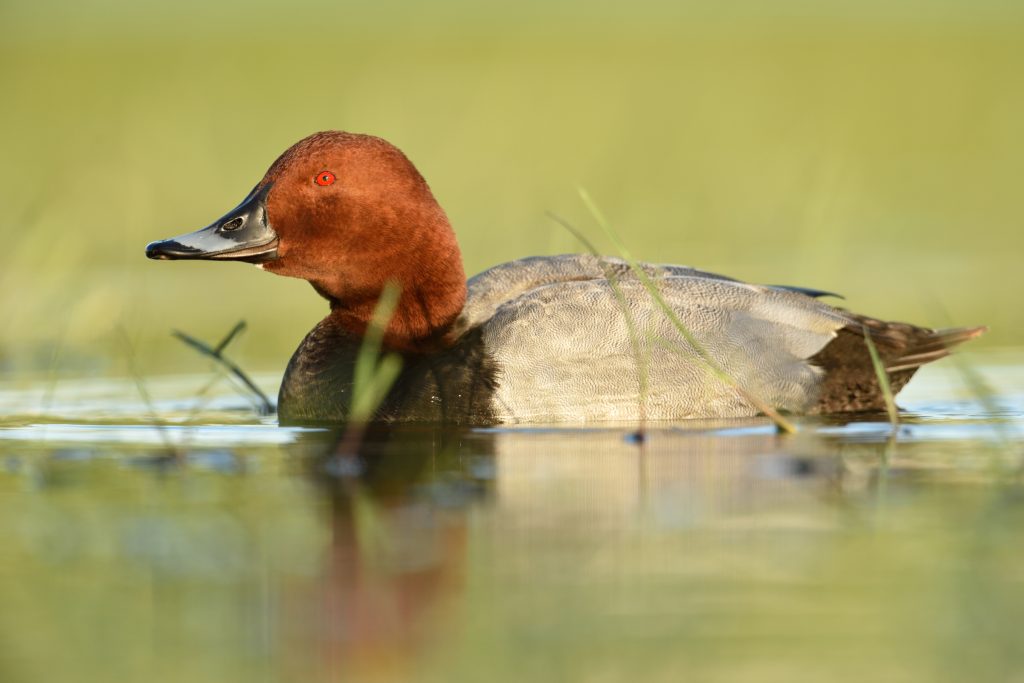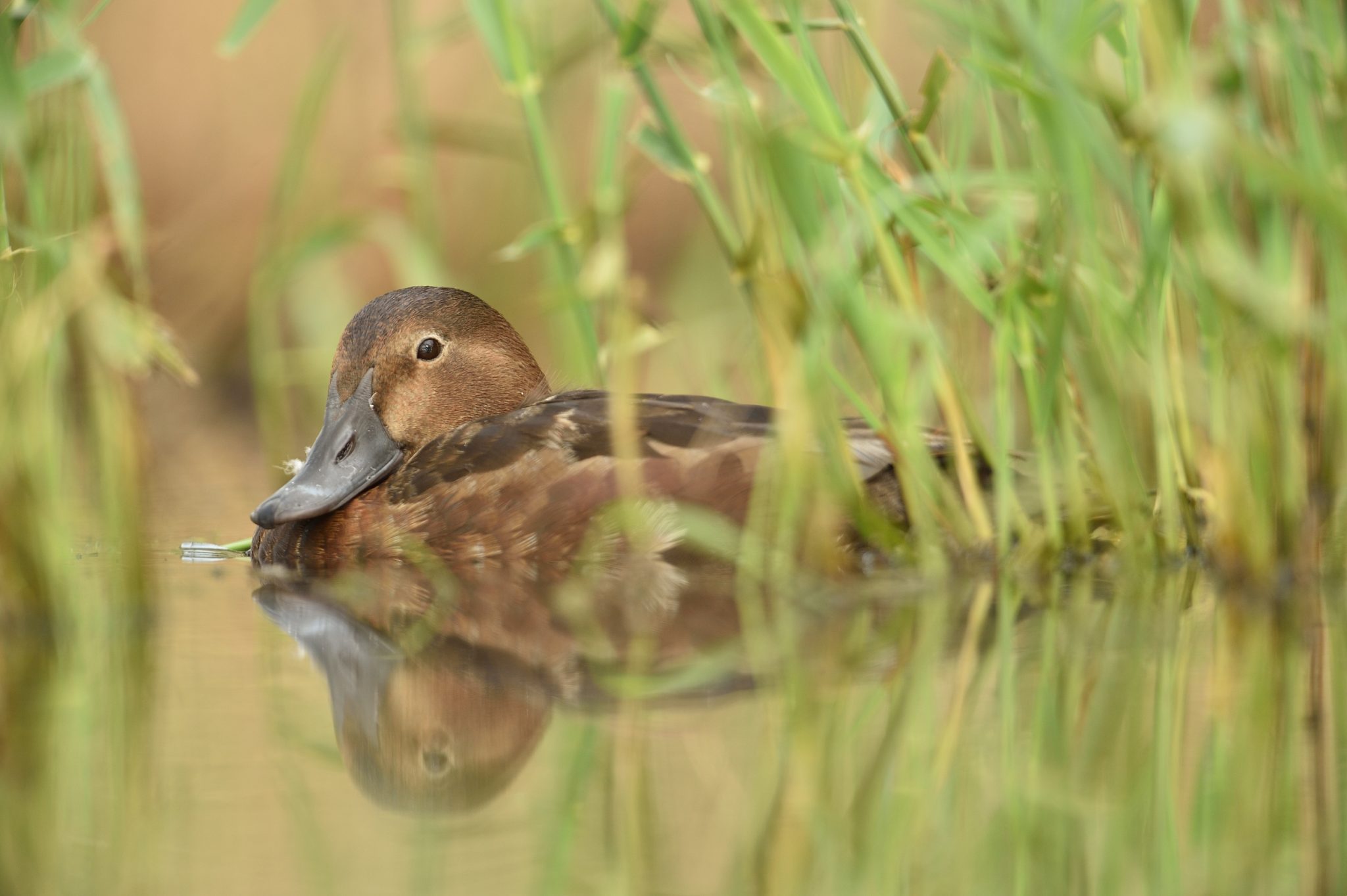Common Pochard (Aythya ferina)

Striking red eyes, vibrant plumage, impressive diving ability and a deep love for wetlands: these are only some of the many distinctive features of this month’s migratory bird, the Common Pochard. As they navigate the challenges of migration across Africa, Europe, and Asia, this species also faces threats from habitat loss, hunting, and pollution. However, with the dedicated efforts of BirdLife Partners, this beloved duck has a chance to thrive once more
Key Facts
- Latin name: Aythya ferina
- IUCN status: Vulnerable1
- Global population: The global population is estimated at 760,000-790,000 mature pairs. The European breeding population is estimated at 89 700-151 000 pairs2
- Migration Route: African-Eurasian, Central Asian, East Asian–Australasian flyways
Description
- Wingspan: 72-82 cm
- Life span: Up to 15 years
- Distinct features: Pale grey wing-bars. In winter and spring, males have a rusty-red head, a black breast and a grey body.
- Favourite food: aquatic plants, seeds, and small invertebrates
- Diving depth: Up to 3 meters
- Habitat: lakes, ponds, marshes and reservoirs with abundant aquatic vegetation.
Flight for survival
Found across lakes and wetlands in Europe and Asia, the Common Pochard is a medium-sized diving duck that adds a splash of colour to watery landscapes—making them hard to miss when in their full breeding glory! During this season, males show off a striking deep chestnut-red head, black breast, and greyish-white body. In contrast, females embrace a more demure look, with brownish-grey plumage, perfect for blending into their nesting spots.
The Common Pochard is a migratory bird that spends its breeding season in northern and eastern Europe, before flying to western, central, southern Europe and North Africa for the winter. Some birds, breeding in the eastern part of its wide range, winter in south-east and east Asia across the Indian sub-continent, reaching as far as Japan. Pochards are expert divers, as they feed on aquatic plants, seeds, and small invertebrates. Because of their diet, they rely on healthy wetland ecosystems to survive.

As many other migratory birds, this species faces several challenges throughout their travels: wetland degradation and destruction due to agricultural expansion, urbanization, and climate change significantly impact their habitats and compromise their welfare. Hunting and lead poisoning from ingested ammunition further threaten its population.
Overhunting and unsustainable practices have severely impacted Pochard populations, prompting calls for tighter controls. To address the downfall of the already shrinking population, the European Commission proposed to develop a population model and Adaptive Harvest Management (AHM) mechanism. These tools will help make informed decisions about the sustainable take of the species, balancing conservation with the needs of hunters and other stakeholders. While these models are being developed, it is recommended for all EU countries to implement a temporary hunting ban.
BirdLife’s work
BirdLife Partners across Europe are working hard to protect the Common Pochard. Their efforts focus on habitat restoration, policy advocacy, and research, as well as raising awareness about the threats this species face.
Pochards heavily depend on healthy wetlands for breeding, feeding, and wintering. BirdLife Partners RSPB (Royal Society for the Protection of Birds) in the UK and LPO (Ligue pour la Protection des Oiseaux) in France work in first place to protect key wetland areas. The two organisations manage and restore crucial habitats such as lakes, marshes, and reedbeds that support waterfowl, including Pochards.
In several countries, BirdLife Partners work to restore degraded lakes by controlling invasive species, reducing nutrient input, and promoting natural vegetation. For example, BirdWatch Ireland has been engaging in projects to reduce agricultural runoff and improve water quality in lakes and wetlands. These actions are needed as agricultural drainage, water pollution, and eutrophication (excessive increase of nutrients in water bodies) are some of the main causes of wetland degradation.
BirdLife Partners in the EU continue to call for a stronger implementation of the EU Water Framework Directive, which aims to protect and restore water bodies across Europe, ensuring sustainable management of these ecosystems. They also urge decision-makers to ensure hunting regulations across Europe are strictly enforced and grounded in scientific evidence.

Accurate data on Pochard populations is critical for informing and guiding conservation actions. Satellite tagging and ringing projects help track pochard movements and identify key migration stopover sites and wintering areas. For example, Ornithologiki/BirdLife Greece and MME/BirdLife Hungary conduct long-term monitoring of waterbird populations, including the Common Pochard, during winter counts and breeding surveys.
In 2023, the Czech Society for Ornithology selected the Common Pochard as their “Bird of the Year”, to draw attention to its conservation needs. This is an example of many education and awareness-raising campaigns that aim at informing the public about the threats faced by Pochards and encouraging sustainable behaviour among local communities and stakeholders.
Interesting facts
Eclipse of the ducks
In ornithology, “eclipse plumage” refers to the dull, camouflaged feathers that drakes (male individuals) temporarily develop after molting. In late summer, drakes lose their bright breeding feathers and actually become flightless! For a short period, they adopt a grey-ish look, that helps them blend in with hens (female individuals). This phase helps them avoid predators until they regrow new feathers.
Diving passion
The Common Pochard is part of the diving ducks club. This duck species are underwater foragers, built to thrive below the surface. With stocky, streamlined bodies, they slice through water with ease, chasing down aquatic plants, snails, insects, and small crustaceans. Dense, well-oiled feathers keep them dry and help them float, while large, webbed feet positioned near their back give them the power to dive and move quickly underwater.
Brood parasitism
Pochards, along with many other duck species, practice what is known as “facultative brood parasitism”: this means that they occasionally lay eggs in the nests of other females or even different duck species’ nests.
Red eyes
The male Common Pochard’s striking red eyes are more than just eye-catching: what might look borderline creepy to us, is actually a feature of high sex appeal for ducks. This vivid colour comes from blood vessels and pigments like carotenoids in the iris, which signals health, maturity, and genetic fitness to potential mates. In many bird species, bold traits like these are key to attracting females, and the Common Pochard’s fiery gaze is no exception.
Cover picture by Yves Adams
- https://www.iucnredlist.org/species/22680358/205288455 ↩︎
- BirdLife International (2024) Species factsheet: Common Pochard Aythya ferina. Downloaded from https://datazone.birdlife.org/species/factsheet/common-pochard-aythya-ferina on 26/09/2024. ↩︎
You might also be interested in:
 | Stichting BirdLife Europe gratefully acknowledges financial support from the European Commission. All content and opinions expressed on these pages are solely those of Stichting BirdLife Europe. The European Commission is not responsible for any use that may be made of the information it contains. |









